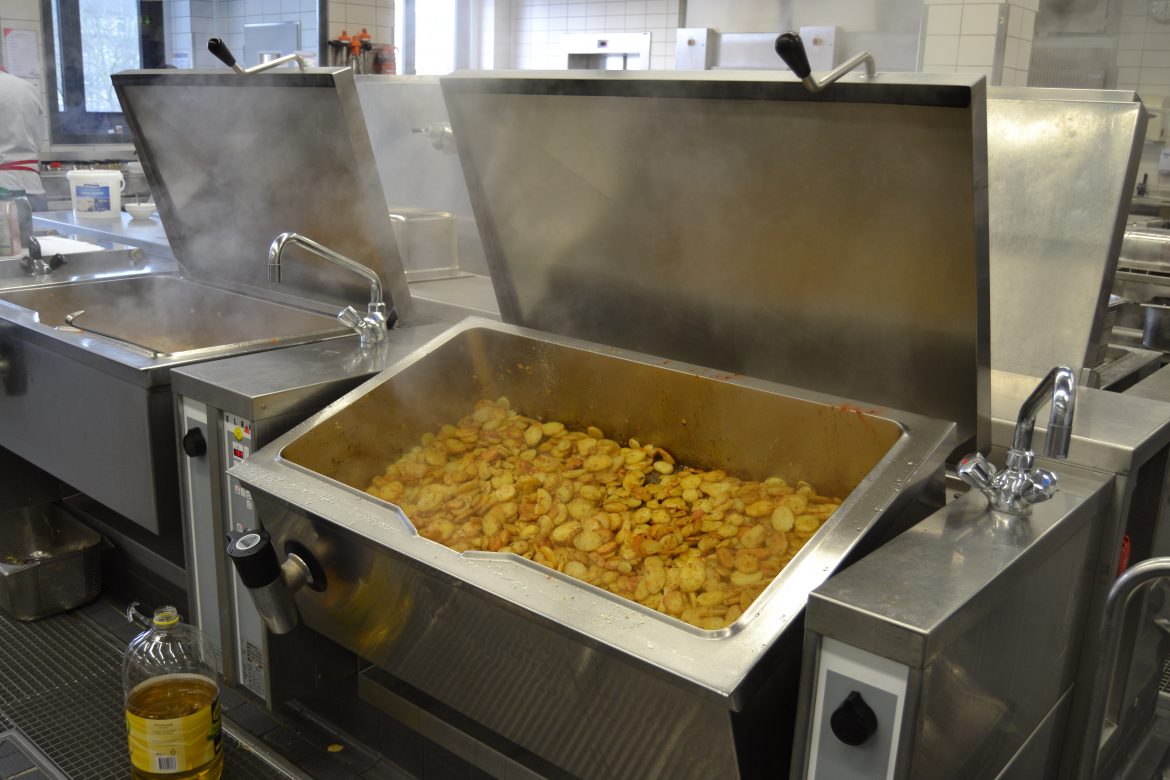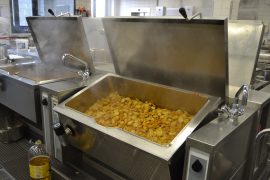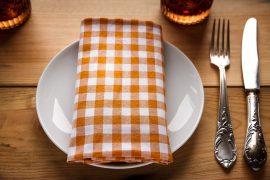It is a place that fills your stomach and soul at once. I can’t imagine my daily life without it! Apart from a warm lunch, it gives me an extended break between lectures, and a chat with friends. What else does a student need for happiness?! In case you have not guessed yet: we are talking about the Z-Mensa, the university’s main canteen.
I’m fascinated by its size. What an organisational effort must be behind this machine that caters for potential 30000 students plus employees? And we are not talking about standard dishes only! The Z-Mensa serves not only classic canteen food such as chips and schnitzel, but also dishes with names such as “Vegan Root Stew pot piquantly flavoured with red wine”, which promise a little more exquisiteness. How huge must the pots be and how oversised the quantities in the recipes?
These are only some of the questions that go through my mind. In a quest to satisfy my intellectual hunger, I arranged an appointment to have a peak behind the scenes of the Z-Mensa. On a Friday afternoon, Frank Sager, Head of Campus Gastronomy, and Steve Saleh, responsible for corporate communications at the Studentenwerk, welcomed me in Sager’s office. Frank Sager is a trained chef; among other places, he cooked in the kitchen of the Steigenberger Hotel Mannheim before taking up business studies.
First, they took me on a tour through the canteen. During the tour, I was overwhelmed by the machinery, could not stop making pictures and all together, felt more like a tourist than a reporter. Once we were back to the office, I could concentrate on the content and pose my numerous questions:
How and according to which criteria are the recipes created?
There is a so-called quality circle, composed of Sager, his deputy, the kitchen manager, a product developer and an ecotrophologist, who meet on a regular basis and test new recipes. Anyone can submit their recipe ideas, by the way: cooks, staff as well as students. The quality circle checks the taste and the appearance of the dishes, as well as their compatibility with large kitchens. If they decide to include the dish in the canteen’s menu, it is photographed and passed on to the chef with the recipe instructions. The last dish that was added to the menu that way is a vegan potato goulash. Let’s see when we’ll have it on our plate for the first time!
How do you calculate the right amount for so many eaters?
Based on experience. The menu is repeated every 6-8 weeks and you know from the experience, how much was eaten. In addition, Campus Gastronomie is now working with a student start-up company that has developed a programme to calculate the quantities. Now, the chef is still in charge of the quantities, which are compared to the programme’s recommendations. If they prove to be accurate, the calculation will be taken over by the programme in the future.
Where does the food come from?
“We work together with permanent partners to ensure quality,” explains Sager. Most ingredients are supplied by SB-Union; meat and potatoes come from local suppliers. Particular attention is paid to the origins of the meat. “Four factors are important to us: Born, raised, slaughtered and cut up in Germany.” However, the meat is not strictly organic. “We are working on this, but are still at the beginning,” says Sager. Some food, especially vegetables, is organic, but not labelled as such. Certification would be too expensive.
And what happens to the leftovers?
“Due to the last-minute offer, there are relatively few leftovers,” says the head of Campus Gastronomie. Everything that was in the guest area, however, must be thrown away, salads for example. However, if there are steaks left, they will be frozen and used later.
What is the most popular food?
“I’m sorry to say it, but it’s the Currywurst, the curry sausage.” Sager admits that this is also one of his favourite dishes.
What does the head of Campus Gastronomie think about the opinion that the food in North Mensa does not taste as good as in other canteens?
“I think that’s a rumour,” he answers without hesitation. In his opinion, however, there are problems in the Northern Mensa with regard to the flow. “This, of course, effects how you perceive the food. I’d say that the North Mensa has gym flair.” He mentions as well that extensive renovations are planned there.
What has changed about canteens since Sager’s time as a student?
“In the old days, the canteen was only for filling up, a mere food dispense. Today, we even set trends for the gastronomy. Our guests always stay young, so we have to keep up with the times and adapt to the trends. As we made the first vegan dish, many were wondering, what it was all about. Now, the chefs identify with it.”
And last but not least: How do the used dishes get back?
[metaslider id=”3239″]



















